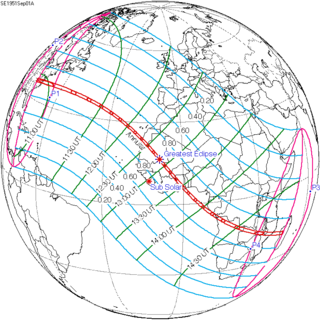
Summary
An annular solar eclipse occurred on Saturday, September 1, 1951. A solar eclipse occurs when the Moon passes between Earth and the Sun, thereby totally or partly obscuring the image of the Sun for a viewer on Earth. An annular solar eclipse occurs when the Moon's apparent diameter is smaller than the Sun's, blocking most of the Sun's light and causing the Sun to look like an annulus (ring). An annular eclipse appears as a partial eclipse over a region of the Earth thousands of kilometres wide. Annularity was visible from the United States, Spanish Sahara (today's West Sahara), French West Africa (the parts now belonging to Mauritania, Mali, Burkina Faso and Ivory Coast), British Gold Coast (today's Ghana), southern tip of French Equatorial Africa (the part now belonging to R. Congo), Belgian Congo (today's DR Congo), Northern Rhodesia (today's Zambia), Portuguese Mozambique (today's Mozambique), Nyasaland (today's Malawi), and French Madagascar (today's Madagascar).
| Solar eclipse of September 1, 1951 | |
|---|---|
 Map | |
| Type of eclipse | |
| Nature | Annular |
| Gamma | 0.1557 |
| Magnitude | 0.9747 |
| Maximum eclipse | |
| Duration | 156 s (2 min 36 s) |
| Coordinates | 16°30′N 8°30′W / 16.5°N 8.5°W |
| Max. width of band | 91 km (57 mi) |
| Times (UTC) | |
| Greatest eclipse | 12:51:51 |
| References | |
| Saros | 134 (40 of 71) |
| Catalog # (SE5000) | 9401 |
Related eclipses edit
Solar eclipses of 1950–1953 edit
This eclipse is a member of a semester series. An eclipse in a semester series of solar eclipses repeats approximately every 177 days and 4 hours (a semester) at alternating nodes of the Moon's orbit.[1]
| Solar eclipse series sets from 1950 to 1953 | ||||||
|---|---|---|---|---|---|---|
| Ascending node | Descending node | |||||
| Saros | Map | Saros | Map | |||
| 119 | 1950 March 18 Annular (non-central) |
124 | 1950 September 12 Total | |||
| 129 | 1951 March 7 Annular |
134 | 1951 September 1Annular 139 1952 February 25 Total |
144 | 1952 August 20 Annular | |
| 149 | 1953 February 14 Partial |
154 | 1953 August 9 Partial | |||
| Solar eclipse of July 11, 1953 belongs to the next lunar year set | ||||||
Saros 134 edit
It is a part of Saros cycle 134, repeating every 18 years, 11 days, containing 71 events. The series started with a partial solar eclipse on June 22, 1248. It contains total eclipses from October 9, 1428 through December 24, 1554 and hybrid eclipses from January 3, 1573 through June 27, 1843, and annular eclipses from July 8, 1861 through May 21, 2384. The series ends at member 71 as a partial eclipse on August 6, 2510. The longest duration of totality was 1 minutes, 30 seconds on October 9, 1428. All eclipses in this series occur at the Moon’s descending node.[2]
| Series members 32–48 occur between 1801 and 2100: | ||||
|---|---|---|---|---|
| 32 | 33 | 34 | ||
| June 6, 1807 |
June 16, 1825 |
June 27, 1843 | ||
| 35 | 36 | 37 | ||
| July 8, 1861 |
July 19, 1879 |
July 29, 1897 | ||
| 38 | 39 | 40 | ||
| August 10, 1915 |
August 21, 1933 |
September 1, 1951 41 42 43 September 11, 1969 |
September 23, 1987 |
October 3, 2005 |
| 44 | 45 | 46 | ||
| October 14, 2023 |
October 25, 2041 |
November 5, 2059 | ||
| 47 | 48 | |||
| November 15, 2077 |
November 27, 2095 | |||
Metonic series edit
The metonic series repeats eclipses every 19 years (6939.69 days), lasting about 5 cycles. Eclipses occur in nearly the same calendar date. In addition, the octon subseries repeats 1/5 of that or every 3.8 years (1387.94 days).
| 22 eclipse events, progressing from north to south between April 8, 1902 and August 31, 1989: | ||||
|---|---|---|---|---|
| April 7–8 | January 24–25 | November 12 | August 31-September 1 | June 19–20 |
| 108 | 114 | 116 | ||
| April 8, 1902 |
August 31, 1913 |
June 19, 1917 | ||
| 118 | 120 | 122 | 124 | 126 |
| April 8, 1921 |
January 24, 1925 |
November 12, 1928 |
August 31, 1932 |
June 19, 1936 |
| 128 | 130 | 132 | 134 | 136 |
| April 7, 1940 |
January 25, 1944 |
November 12, 1947 |
September 1, 1951 |
June 20, 1955 |
| 138 | 140 | 142 | 144 | 146 |
| April 8, 1959 |
January 25, 1963 |
November 12, 1966 |
August 31, 1970 |
June 20, 1974 |
| 148 | 150 | 152 | 154 | |
| April 7, 1978 |
January 25, 1982 |
November 12, 1985 |
August 31, 1989 | |
Notes edit
References edit
- Earth visibility chart and eclipse statistics Eclipse Predictions by Fred Espenak, NASA/GSFC
- Google interactive map
- Besselian elements


